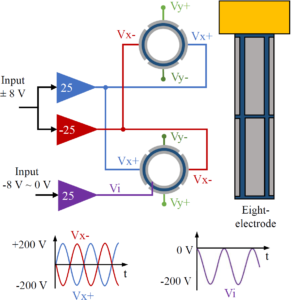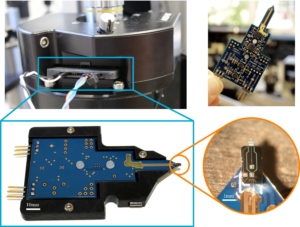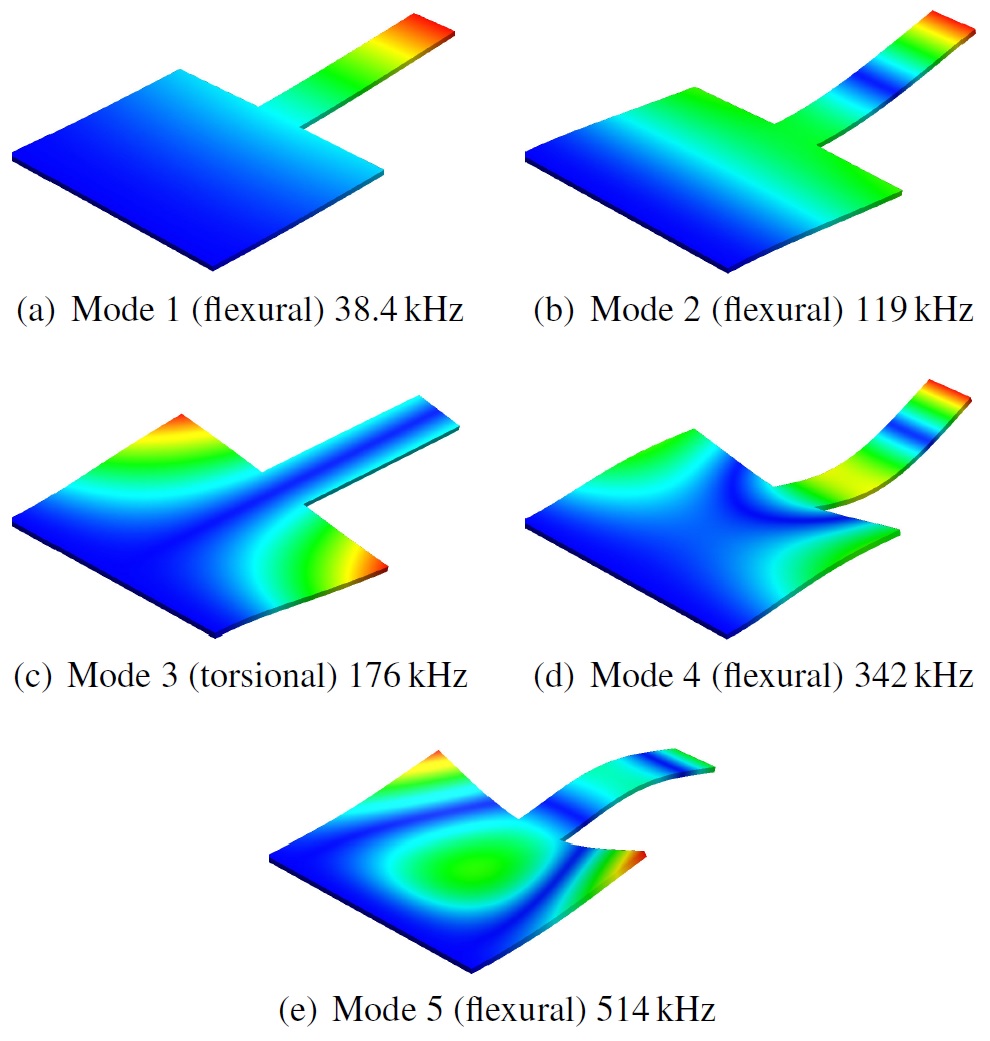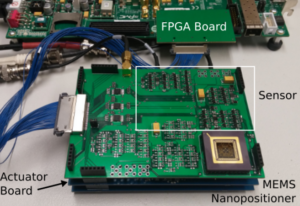Biography
Steven Moore is currently a post-doctoral researcher with the Precision Mechatronics Lab at the University of Newcastle, Australia. He received his doctorate in electrical engineering from the University of Newcastle in 2016. His research focuses on the modelling, instrumentation and control of microsystems.
Awards
- Dean of Engineering’s Medal (2011)
- Australian Postgraduate Award (2012)
Teaching Experience
The University of Newcastle, Callaghan Campus
- ELEC1300 Electircal Circuits I
Tutor and Lab Demonstrator (2012 and 2013 )
Conferences Attended
- Australian Control Conference, Sydney, Australia (2013)
- IFAC Mechatronics (2013)
- AIM (2014)
- IFAC World Congress (2014)
- ACC (2016)
- IEEE ICM (2017)
Publications
2021

M. Omidbeike; S. I. Moore; Y. K. Yong; A. J. Fleming
Five-Axis Bimorph Monolithic Nanopositioning Stage: Design, Modeling, and Characterization Journal Article
In: Sensors and Actuators A: Physical, vol. 332, iss. 1, 2021, ISSN: 0924-4247.
@article{Omidbeike2021,
title = {Five-Axis Bimorph Monolithic Nanopositioning Stage: Design, Modeling, and Characterization},
author = {M. Omidbeike and S. I. Moore and Y. K. Yong and A. J. Fleming},
url = {https://www.precisionmechatronicslab.com/wp-content/uploads/2022/03/J21g.pdf},
doi = {10.1016/j.sna.2021.113125},
issn = {0924-4247},
year = {2021},
date = {2021-09-16},
urldate = {2021-09-16},
journal = {Sensors and Actuators A: Physical},
volume = {332},
issue = {1},
abstract = {The article describes the design and modeling of a five-axis monolithic nanopositioning stage constructed from a bimorph piezoelectric sheet. Six-axis motion is also possible but requires 16 amplifier channels rather than 8. The nanopositioner is ultra low profile with a thickness of 1 mm. Analytical modeling and finite-element-analysis accurately predict the experimental performance. The stage was conservatively driven with 33% of the maximum voltage, which resulted in an X and Y travel range of 6.22 μm and 5.27 μm respectively; a Z travel range of 26.5 μm; and a rotational motion of 600 μrad and 884 μrad about the X and Y axis respectively. The first resonance frequency occurs at 883 Hz in the Z axis. Experimental atomic force microscopy is performed using the proposed device as a sample scanner.},
keywords = {},
pubstate = {published},
tppubtype = {article}
}

S. I. Moore; Y. K. Yong; M. Omidbeike; A. J. Fleming
Serial-kinematic monolithic nanopositioner with in-plane bender actuators Journal Article
In: Mechatronics, vol. 75, no. 102541, 2021, ISBN: 0957-4158.
@article{Moore2021,
title = {Serial-kinematic monolithic nanopositioner with in-plane bender actuators},
author = {S. I. Moore and Y. K. Yong and M. Omidbeike and A. J. Fleming},
url = {https://www.precisionmechatronicslab.com/wp-content/uploads/2021/03/J21c.pdf},
doi = {https://doi.org/10.1016/j.mechatronics.2021.102541},
isbn = {0957-4158},
year = {2021},
date = {2021-03-23},
journal = {Mechatronics},
volume = {75},
number = {102541},
abstract = {This article describes a monolithic nanopositioner constructed from in-plane bending actuators which provide greater deflection than previously reported extension actuators, at the expense of stiffness and resonance frequency. The proposed actuators are demonstrated by constructing an XY nanopositioning stage with a serial kinematic design. Analytical modeling and finite-element-analysis accurately predicts the experimental performance of the nanopositioner. A 10μm range is achieved in the X and Y axes with an applied voltage of +/-200 V. The first resonance mode occurs at 250 Hz in the Z axis. The stage is demonstrated for atomic force microscopy imaging.},
keywords = {},
pubstate = {published},
tppubtype = {article}
}
2020

D. S. Raghunvanshi; S. I. Moore; A. J. Fleming; Y. K. Yong
Electrode Configurations for Piezoelectric Tube Actuators With Improved Scan Range and Reduced Cross-Coupling Journal Article
In: IEEE/ASME Transactions on Mechatronics, vol. 25, no. 3, pp. 1479-1486, 2020, ISSN: 00346748.
@article{J20d,
title = {Electrode Configurations for Piezoelectric Tube Actuators With Improved Scan Range and Reduced Cross-Coupling},
author = {D. S. Raghunvanshi and S. I. Moore and A. J. Fleming and Y. K. Yong},
url = {https://www.precisionmechatronicslab.com/wp-content/uploads/2020/09/J20d.pdf},
doi = {10.1109/TMECH.2020.2978241},
issn = {00346748},
year = {2020},
date = {2020-06-01},
journal = {IEEE/ASME Transactions on Mechatronics},
volume = {25},
number = {3},
pages = {1479-1486},
abstract = {Piezoelectric force and position sensors provide high sensitivity but are limited at low frequencies due to their high-pass response which complicates the direct application of integral control. To overcome this issue, an additional sensor or low-frequency correction method is typically employed. However, these approaches introduce an additional first-order response that must be higher than the high-pass response of the piezo and interface electronics. This article describes a simplified method for low-frequency correction that uses the piezoelectric sensor as an electrical component in a filter circuit. The resulting response is first-order, rather than second-order, with a cut-off frequency equal to that of a buffer circuit with the same input resistance. The proposed method is demonstrated to allow simultaneous damping and tracking control of a high-speed vertical nanopositioning stage.},
keywords = {},
pubstate = {published},
tppubtype = {article}
}

S. I. Moore; M. G. Ruppert; Y. K. Yong
AFM Cantilever Design for Multimode Q Control: Arbitrary Placement of Higher-Order Modes Journal Article
In: IEEE/ASME Transactions on Mechatronics, pp. 1-6, 2020, (This work was supported by the Australian Research Council Discovery Project DP170101813).
@article{Moore2020,
title = {AFM Cantilever Design for Multimode Q Control: Arbitrary Placement of Higher-Order Modes},
author = {S. I. Moore and M. G. Ruppert and Y. K. Yong},
url = {https://ieeexplore.ieee.org/document/9006926},
doi = {10.1109/TMECH.2020.2975627},
year = {2020},
date = {2020-02-21},
urldate = {2020-02-21},
journal = { IEEE/ASME Transactions on Mechatronics},
pages = {1-6},
abstract = {In the fast growing field of multifrequency atomic force microscopy (AFM), the benefits of using higher-order modes has been extensively reported on. However, higher modes of AFM cantilevers are difficult to instrument and Q control is challenging owing to their high frequency nature. At these high frequencies, the latencies in the computations and analog conversions of digital signal processing platforms become significant and limit the effective bandwidth of digital feedback controller implementations. To address this issue, this article presents a novel cantilever design for which the first five modes are placed within a 200 kHz bandwidth. The proposed cantilever is designed using a structural optimization routine. The close spacing and low mechanical bandwidth of the resulting cantilever allows for the implementation of Q controllers for all five modes using a standard FPGA development board for bimodal AFM and imaging on higher-order modes.},
note = {This work was supported by the Australian Research Council Discovery Project DP170101813},
keywords = {},
pubstate = {published},
tppubtype = {article}
}
2019

S. I. Moore; A. J. Fleming; Y. K. Yong
Capacitive Instrumentation and Sensor Fusion for High-Bandwidth Nanopositioning Journal Article
In: IEEE Sensor Letters, vol. 3, no. 8, pp. 2501503, 2019, ISBN: 2475-1472.
@article{Moore2019,
title = {Capacitive Instrumentation and Sensor Fusion for High-Bandwidth Nanopositioning},
author = {S. I. Moore and A. J. Fleming and Y. K. Yong},
url = {https://www.precisionmechatronicslab.com/wp-content/uploads/2019/10/J19c.pdf},
doi = {10.1109/LSENS.2019.2933065},
isbn = {2475-1472},
year = {2019},
date = {2019-09-09},
journal = {IEEE Sensor Letters},
volume = {3},
number = {8},
pages = {2501503},
abstract = {Precision capacitive sensing methods encode the measurement in a high frequency signal, which requires demodulation. To extract the measurement, the signal is observed over many cycles limiting the bandwidth of the sensor and introducing an undesirable phase lag. To address this limitation, this article outlines a design, which fuses the output of a standard modulated capacitive sensor and a charge amplifier, providing an instantaneous capacitive measurement whose bandwidth is only limited by the speed at which the electronics operate.},
keywords = {},
pubstate = {published},
tppubtype = {article}
}

S. I. Moore; M. G. Ruppert; Y. K. Yong
An optimization framework for the design of piezoelectric AFM cantilevers Journal Article
In: Precision Engineering, vol. 60, pp. 130-142, 2019, (This work was supported by the Australian Research Council Discovery Project DP170101813).
@article{Moore2019c,
title = {An optimization framework for the design of piezoelectric AFM cantilevers},
author = {S. I. Moore and M. G. Ruppert and Y. K. Yong},
url = {https://www.sciencedirect.com/science/article/pii/S0141635919302260},
year = {2019},
date = {2019-08-15},
urldate = {2019-08-15},
journal = {Precision Engineering},
volume = {60},
pages = {130-142},
abstract = {To facilitate further miniaturization of atomic force microscopy (AFM) cantilevers and to eliminate the standard optical beam deflection sensor, integrated piezoelectric actuation and sensing on the chip level is a promising option. This article presents a topology optimization method for dynamic mode AFM cantilevers that maximizes the sensitivity of an integrated piezoelectric sensor under stiffness and resonance frequency constraints. Included in the formulation is a new material model C-SIMP (connectivity and solid isotropic material with penalization) that extends the SIMP model to explicitly include the penalization of unconnected structures. Example cantilever designs demonstrate the potential of the topology optimization method. The results show, firstly, the C-SIMP material model significantly reduces connectivity issues and, secondly, arbitrary cantilever topologies can produce increases in sensor sensitivity or resonance frequency compared to a rectangular topology.},
note = {This work was supported by the Australian Research Council Discovery Project DP170101813},
keywords = {},
pubstate = {published},
tppubtype = {article}
}

S. I. Moore; M. G. Ruppert; D. M. Harcombe; A. J. Fleming; Y. K. Yong
Design and Analysis of Low-Distortion Demodulators for Modulated Sensors Journal Article
In: IEEE/ASME Transactions on Mechatronics, vol. 24, no. 4, pp. 1861-1870, 2019, ISSN: 10834435, (This work was supported by the Australian Research Council Discovery Project DP170101813).
@article{Moore2019,
title = {Design and Analysis of Low-Distortion Demodulators for Modulated Sensors},
author = { S. I. Moore and M. G. Ruppert and D. M. Harcombe and A. J. Fleming and Y. K. Yong },
url = {https://www.precisionmechatronicslab.com/wp-content/uploads/2020/05/J19d-reduced.pdf},
doi = {10.1109/TMECH.2019.2928592},
issn = {10834435},
year = {2019},
date = {2019-07-17},
urldate = {2019-07-17},
journal = {IEEE/ASME Transactions on Mechatronics},
volume = {24},
number = {4},
pages = {1861-1870},
abstract = {System-based demodulators in the form of a Kalman and Lyapunov filter have been demonstrated to significantly outperform traditional demodulators, such as the lock-in amplifier, in bandwidth sensitive applications, for example high-speed atomic force microscopy. Building on their closed loop architecture, this article describes a broader class of high-speed closed-loop demodulators. The generic structure provides greater flexibility to independently control the bandwidth and sensitivity to out-of-band frequencies. A linear time-invariant description is derived which allows the utilization of linear control theory to design the demodulator. Experimental results on a nanopositioner with capacitive sensors demonstrate the realization of arbitrary demodulator dynamics while achieving excellent noise rejection.},
note = {This work was supported by the Australian Research Council Discovery Project DP170101813},
keywords = {},
pubstate = {published},
tppubtype = {article}
}

M. Omidbeike; Y. K. Yong; S. I. Moore; A. J. Fleming
A Five-Axis Monolithic Nanopositioning Stage Constructed from a Bimorph Piezoelectric Sheet Proceedings Article
In: International Conference on Manipulation, Automation and Robotics at Small Scales , Helsinki, Finland, 2019, ISSN: 978-1-7281-0948-0.
@inproceedings{omidbeike2019axis},
title = {A Five-Axis Monolithic Nanopositioning Stage Constructed from a Bimorph Piezoelectric Sheet},
author = {M. Omidbeike and Y. K. Yong and S. I. Moore and A. J. Fleming
},
url = {https://www.precisionmechatronicslab.com/wp-content/uploads/2021/02/C19a.pdf},
doi = {10.1109/MARSS.2019.8860940},
issn = {978-1-7281-0948-0},
year = {2019},
date = {2019-07-02},
urldate = {2019-07-02},
booktitle = {International Conference on Manipulation, Automation and Robotics at Small Scales },
journal = {Int. Conference on Manipulation, Automation and Robotics at Small Scales (MARSS)},
address = {Helsinki, Finland},
abstract = {The paper describes design, modeling and control of a five-axis monolithic nanopositioning stage constructed from a bimorph piezoelectric sheet. In this design, actuators are created by removing parts of the sheet using ultrasonic machining. The constructed nanopositioner is ultra-compact with a thickness of 1 mm. It has a X and Y travel range of 15.5 µm and 13.2 µm respectively; a Z travel range of 26 µm; and a rotational motion about the X-and Y-axis of 600 µrad and 884 µrad respectively. The first resonance frequency occurs at 883 Hz in the Z-axis, and the second and third resonance frequency appears at 1850 Hz, rotating about the X-and Y-axis. A decentralized control strategy is implemented to track Z, θx and θy motions. The controller provides good tracking and significantly reduces cross-coupling motions among the three degrees-of-freedom.},
keywords = {},
pubstate = {published},
tppubtype = {inproceedings}
}

M. G. Ruppert; S. I. Moore; M. Zawierta; A. J. Fleming; G. Putrino; Y. K. Yong
Multimodal atomic force microscopy with optimized higher eigenmode sensitivity using on-chip piezoelectric actuation and sensing Journal Article
In: Nanotechnology, vol. 30, no. 8, pp. 085503, 2019, (This work was supported by the Australian Research Council Discovery Project DP170101813).
@article{Ruppert2018b,
title = {Multimodal atomic force microscopy with optimized higher eigenmode sensitivity using on-chip piezoelectric actuation and sensing},
author = {M. G. Ruppert and S. I. Moore and M. Zawierta and A. J. Fleming and G. Putrino and Y. K. Yong},
url = {https://www.precisionmechatronicslab.com/wp-content/uploads/2019/08/Ruppert_2019_Nanotechnology_30_085503.pdf},
doi = {https://doi.org/10.1088/1361-6528/aae40b},
year = {2019},
date = {2019-01-02},
urldate = {2019-01-02},
journal = {Nanotechnology},
volume = {30},
number = {8},
pages = {085503},
abstract = {Atomic force microscope (AFM) cantilevers with integrated actuation and sensing provide several distinct advantages over conventional cantilever instrumentation. These include clean frequency responses, the possibility of down-scaling and parallelization to cantilever arrays as well as the absence of optical interference. While cantilever microfabrication technology has continuously advanced over the years, the overall design has remained largely unchanged; a passive rectangular shaped cantilever design has been adopted as the industry wide standard. In this article, we demonstrate multimode AFM imaging on higher eigenmodes as well as bimodal AFM imaging with cantilevers using fully integrated piezoelectric actuation and sensing. The cantilever design maximizes the higher eigenmode deflection sensitivity by optimizing the transducer layout according to the strain mode shape. Without the need for feedthrough cancellation, the read-out method achieves close to zero actuator/sensor feedthrough and the sensitivity is sufficient to resolve the cantilever Brownian motion.},
note = {This work was supported by the Australian Research Council Discovery Project DP170101813},
keywords = {},
pubstate = {published},
tppubtype = {article}
}
2018

S. I. Moore; M. Omidbeike; A. J. Fleming; Y. K. Yong
A monolithic serial-kinematic nanopositioner with integrated sensors and actuators Proceedings Article
In: IEEE International Conference on Advanced Intelligent Mechatronics, Auckland, New Zealand, 2018.
@inproceedings{C18e,
title = {A monolithic serial-kinematic nanopositioner with integrated sensors and actuators},
author = {S. I. Moore and M. Omidbeike and A. J. Fleming and Y. K. Yong},
url = {https://www.precisionmechatronicslab.com/wp-content/uploads/2021/02/C18e.pdf},
doi = {10.1109/AIM.2018.8452225},
year = {2018},
date = {2018-07-04},
booktitle = {IEEE International Conference on Advanced Intelligent Mechatronics},
address = {Auckland, New Zealand},
abstract = {This article describes the design, modeling and simulation of a serial-kinematic nanopositioner machined from a single sheet of piezoelectric material. In this class of nanopositioners, the flexures, sensors and actuators are completely integrated into a single monolithic structure. A non-trivial electrode topology is etched into the sheet to achieve in-plane bending and displacement of the moving platform. Finite element analysis predicts a sensitivity of 18.6 nm/V in the x-axis and 18.1 nm/V in the yaxis with a voltage limit of −250V to 1000 V. The first resonance frequency is 250 Hz in the Z axis. This design enables high-speed, long-range, lateral positioning in space-limited applications.},
keywords = {},
pubstate = {published},
tppubtype = {inproceedings}
}

S. I. Moore; M. G. Ruppert; Y. K. Yong
Arbitrary placement of AFM cantilever higher eigenmodes using structural optimization Proceedings Article
In: International Conference on Manipulation, Automation and Robotics at Small Scales (MARSS), 2018, (This work was supported by the Australian Research Council Discovery Project DP170101813).
@inproceedings{Moore2018,
title = {Arbitrary placement of AFM cantilever higher eigenmodes using structural optimization},
author = {S. I. Moore and M. G. Ruppert and Y. K. Yong},
year = {2018},
date = {2018-07-04},
urldate = {2018-07-04},
booktitle = {International Conference on Manipulation, Automation and Robotics at Small Scales (MARSS)},
journal = {International Conference on Manipulation, Automation and Robotics at Small Scales (MARSS)},
abstract = {This article presents a novel cantilever design approach to place higher mode frequencies within a specific frequency band to alleviate instrumentation and Q control feasibility. This work is motivated by the emerging field of multifrequency atomic force microscopy (AFM) which involves the excitation and/or detection of several cantilever modes at once. Unlike other operating modes, multifrequency AFM allows the tracking of the sample topography on the fundamental mode while simultaneously acquiring complimentary nanomechanical information on a higher mode. However, higher modes of conventional rectangular tapping-mode cantilevers are usually in the MHz regime and therefore impose severe restrictions on the direct controllability of these modes. To overcome this limitation, an optimization technique is employed which is capable of placing the first five modes within a 200 kHz bandwidth.},
note = {This work was supported by the Australian Research Council Discovery Project DP170101813},
keywords = {},
pubstate = {published},
tppubtype = {inproceedings}
}

M. G. Ruppert; D. M. Harcombe; S. I. Moore; A. J. Fleming
Direct Design of Closed-loop Demodulators for Amplitude Modulation Atomic Force Microscopy Proceedings Article
In: American Control Conference, Milwaukee, WI, 2018.
@inproceedings{C18b,
title = {Direct Design of Closed-loop Demodulators for Amplitude Modulation Atomic Force Microscopy},
author = {M. G. Ruppert and D. M. Harcombe and S. I. Moore and A. J. Fleming},
url = {https://www.precisionmechatronicslab.com/wp-content/uploads/2021/02/C18b.pdf},
doi = {10.23919/ACC.2018.8430896},
year = {2018},
date = {2018-06-27},
booktitle = {American Control Conference},
address = {Milwaukee, WI},
abstract = {A fundamental component of the z-axis feedback loop in amplitude modulation atomic force microscopy is the demodulator. It dictates both bandwidth and noise in the amplitude and phase estimate of the cantilever deflection signal. In this paper, we derive a linear time-invariant model of a closedloop demodulator with user definable tracking bandwidth and sensitivity to other frequency components. A direct demodulator design method is proposed based on the reformulation of the Lyapunov filter as a modulated-demodulated controller in closed loop with a unity plant. Simulation and experimental results for a higher order Lyapunov filter as well as Butterworth and Chebyshev type demodulators are presented.},
keywords = {},
pubstate = {published},
tppubtype = {inproceedings}
}

M. G. Ruppert; S. I. Moore; M. Zawierta; G. Putrino; Y. K. Yong
Advanced Sensing and Control with Active Cantilevers for Multimodal Atomic Force Microscopy Conference
7th Multifrequency AFM Conference, Madrid, Spain, 2018, (This work was supported by the Australian Research Council Discovery Project DP170101813).
@conference{Ruppert2018,
title = {Advanced Sensing and Control with Active Cantilevers for Multimodal Atomic Force Microscopy},
author = {M. G. Ruppert and S. I. Moore and M. Zawierta and G. Putrino and Y. K. Yong},
year = {2018},
date = {2018-04-18},
urldate = {2018-04-18},
booktitle = {7th Multifrequency AFM Conference},
address = {Madrid, Spain},
abstract = {Atomic force microscopy (AFM) cantilevers with integrated actuation and sensing on the chip level provide several distinct advantages over conventional cantilever instrumentation. These include clean frequency responses, the possibility of down-scaling and parallelization to cantilever arrays as well as the absence of optical interferences. While cantilever microfabrication technology has continuously advanced over the years, the overall design has remained largely unchanged; a passive rectangular shaped cantilever design has been adopted as the industry wide standard. Consequently, conventional cantilever instrumentation requires external piezo acoustic excitation as well as an external optical deflection sensor. Both of these components are not optimal for current trends in multifrequency AFM technology which revolve around further down-sizing, parallelization and measurements at multiple higher eigenmodes. Using microelectromechanical systems (MEMS) fabrication processes, this work aims to optimize cantilever instrumentation by realizing a new class of probes with high-performance integrated actuators and sensors. Equipped with multiple integrated piezoelectric layers for both actuation and sensing, these cantilevers are capable of achieving an increased higher eigenmode sensitivity and/or guaranteed collocated system properties compared to commercially available counterparts; examples of such designs are shown in Figure 1. The geometry as well as the integrated actuator/sensor arrangement is optimized using finite element modelling with individual design goals. The designs are realized using a commercial MEMS fabrication process and only require a simple five-mask patterning and etching process and post-fabricated sharp tips.},
note = {This work was supported by the Australian Research Council Discovery Project DP170101813},
keywords = {},
pubstate = {published},
tppubtype = {conference}
}
2017

S. I. Moore; M. G. Ruppert; Y. K. Yong
Design and Analysis of Piezoelectric Cantilevers with Enhanced Higher Eigenmodes for Atomic Force Microscopy Proceedings Article
In: IEEE/ASME Advanced Intelligent Mechatronics (AIM), Munich, Germany, 2017, (This work was supported by the Australian Research Council Discovery Project DP170101813).
@inproceedings{Moore2017b,
title = {Design and Analysis of Piezoelectric Cantilevers with Enhanced Higher Eigenmodes for Atomic Force Microscopy},
author = {S. I. Moore and M. G. Ruppert and Y. K. Yong},
year = {2017},
date = {2017-07-02},
urldate = {2017-07-02},
booktitle = {IEEE/ASME Advanced Intelligent Mechatronics (AIM)},
address = {Munich, Germany},
abstract = {Atomic force microscope (AFM) cantilevers with
integrated actuation and sensing provide several distinct advantages
over conventional cantilever instrumentation such as
clean frequency responses, the possibility of down-scaling and
parallelization to cantilever arrays as well as the absence of optical
interferences. However, for multifrequency AFM techniques
involving higher eigenmodes of the cantilever, optimization
of the transducer location and layout has to be taken into
account. This work proposes multiple integrated piezoelectric
regions on the cantilever which maximize the deflection of the
cantilever and the piezoelectric charge response for a given
higher eigenmode based on the spatial strain distribution. Finite
element analysis is performed to find the optimal transducer
topology and experimental results are presented which highlight
an actuation gain improvement up to 42 dB on the third mode
and sensor sensitivity improvement up to 38 dB on the second
mode.},
note = {This work was supported by the Australian Research Council Discovery Project DP170101813},
keywords = {},
pubstate = {published},
tppubtype = {inproceedings}
}
integrated actuation and sensing provide several distinct advantages
over conventional cantilever instrumentation such as
clean frequency responses, the possibility of down-scaling and
parallelization to cantilever arrays as well as the absence of optical
interferences. However, for multifrequency AFM techniques
involving higher eigenmodes of the cantilever, optimization
of the transducer location and layout has to be taken into
account. This work proposes multiple integrated piezoelectric
regions on the cantilever which maximize the deflection of the
cantilever and the piezoelectric charge response for a given
higher eigenmode based on the spatial strain distribution. Finite
element analysis is performed to find the optimal transducer
topology and experimental results are presented which highlight
an actuation gain improvement up to 42 dB on the third mode
and sensor sensitivity improvement up to 38 dB on the second
mode.

S. I. Moore; Y. K. Yong
Design and Characterization of Cantilevers for Multi-Frequency Atomic Force Microscopy Journal Article
In: Micro & Nano Letters, vol. 12, no. 5, pp. 315-320, 2017, (This work was supported by the Australian Research Council Discovery Project DP170101813).
@article{Moore2017,
title = {Design and Characterization of Cantilevers for Multi-Frequency Atomic Force Microscopy},
author = {S. I. Moore and Y. K. Yong},
url = {https://www.precisionmechatronicslab.com/wp-content/uploads/2017/01/MNL.2016.0586.pdf},
doi = {10.1049/mnl.2016.0586},
year = {2017},
date = {2017-03-01},
urldate = {2017-03-01},
journal = {Micro & Nano Letters},
volume = {12},
number = {5},
pages = {315-320},
abstract = {The experimental characterisation of a set of microcantilevers targeted at use in multi-frequency atomic force microscope is presented. The aim of this work is to design a cantilever that naturally amplifies its harmonic oscillations which are introduced by nonlinear probe–sample
interaction forces. This is performed by placing the modal frequencies of the cantilever at integer multiples of the first modal frequency. The developed routine demonstrates the placement of the frequency of the second to fifth mode. The characterisation shows a trend that
lower-order modes are more accurately placed than higher-order modes. With two fabricated designs, the error in the second mode is at most 2.26% while the greatest error in the fifth mode is at 10.5%.},
note = {This work was supported by the Australian Research Council Discovery Project DP170101813},
keywords = {},
pubstate = {published},
tppubtype = {article}
}
interaction forces. This is performed by placing the modal frequencies of the cantilever at integer multiples of the first modal frequency. The developed routine demonstrates the placement of the frequency of the second to fifth mode. The characterisation shows a trend that
lower-order modes are more accurately placed than higher-order modes. With two fabricated designs, the error in the second mode is at most 2.26% while the greatest error in the fifth mode is at 10.5%.

S. I. Moore; Y. K. Yong; S. O. R. Moheimani
Switched Self-Sensing Actuator for a MEMS Nanopositioner Proceedings Article
In: International Conference on Mechatronics, Gippsland, Australia, 2017.
@inproceedings{Moore2017b,
title = {Switched Self-Sensing Actuator for a MEMS Nanopositioner},
author = {S. I. Moore and Y. K. Yong and S. O. R. Moheimani},
url = {https://www.precisionmechatronicslab.com/wp-content/uploads/2017/03/sensor-note.pdf},
year = {2017},
date = {2017-02-15},
booktitle = {International Conference on Mechatronics},
address = {Gippsland, Australia},
abstract = {This work outlines the instrumentation and actuation of a MEMS nanopositioner, implementing a switching electronics based self-sensing actuation technique. Self-sensing actuation allows for optimal use of transducer die space in MEMS designs. The switching design accommodates actuation voltages of 50V and is compatible with the silicon-on-insulator microfabrication process. The switching electronics are designed to be directly interfaced to a digital control platform. The actuator is based on the class D amplifier and the sensor is implemented using a modulator to create a displacement-to-digital type sensor that is operated at 1MHz.},
keywords = {},
pubstate = {published},
tppubtype = {inproceedings}
}

S. I. Moore; M. G. Ruppert; Y. K. Yong
Multimodal cantilevers with novel piezoelectric layer topology for sensitivity enhancement Journal Article
In: Beilstein Journal of Nanotechnology, vol. 8, pp. 358–371, 2017, (This work was supported by the Australian Research Council Discovery Project DP170101813).
@article{Moore2017b,
title = {Multimodal cantilevers with novel piezoelectric layer topology for sensitivity enhancement},
author = {S. I. Moore and M. G. Ruppert and Y. K. Yong},
url = {https://www.precisionmechatronicslab.com/wp-content/uploads/2017/02/2190-4286-8-38.pdf},
year = {2017},
date = {2017-02-06},
urldate = {2017-02-06},
journal = {Beilstein Journal of Nanotechnology},
volume = {8},
pages = {358--371},
abstract = {Self-sensing techniques for atomic force microscope (AFM) cantilevers have several advantageous characteristics compared to the optical beam deflection method. The possibility of down scaling, parallelization of cantilever arrays and the absence of optical interference associated imaging artifacts have led to an increased research interest in these methods. However, for multifrequency AFM, the optimization of the transducer layout on the cantilever for higher order modes has not been addressed. To fully utilize an integrated piezoelectric transducer, this work alters the layout of the piezoelectric layer to maximize both the deflection of the cantilever and measured piezoelectric charge response for a given mode with respect to the spatial distribution of the strain. On a prototype cantilever design, significant increases in actuator and sensor sensitivities were achieved for the first four modes without any substantial increase in sensor noise. The transduction mechanism is specifically targeted at multifrequency AFM and has the potential to provide higher resolution imaging on higher order modes.},
note = {This work was supported by the Australian Research Council Discovery Project DP170101813},
keywords = {},
pubstate = {published},
tppubtype = {article}
}

